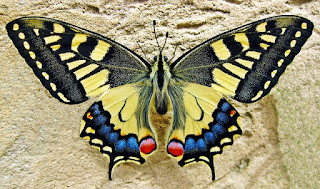The Southern Scarce Swallowtail
Southern Scarce Swallowtail (Photo: Steve Andrews)
There are two types of swallowtail butterfly seen flying in Portugal, and one of these is known as the Southern Swallowtail or Southern Scarce Swallowtail (Iphiclides feisthamelii). A large and very beautiful insect it is often regarded as a subspecies of the very similar Scarce Swallowtail (I. podalirius). This latter species is actually a fairly common butterfly across many parts of Europe, but it earned its moniker because of rare migrants or strays that made it to the UK, where it is indeed a very “scarce” butterfly.
The Southern Scarce Swallowtail is also found in Spain, Italy, Morocco, Algeria and Tunisia. It frequents gardens and parks as well as the countryside and will definitely catch your eye as it soars and glides or sips nectar from flowers. It has attractively marked wings of pale yellow or cream with black bands and markings, and at the tips of the rear wings are the characteristic “swallowtail” projections that are bordered by blue spots against more black.
The Swallowtail
The Swallowtail (Papilio machaon) is a very rare species in the UK where it is confined to the fens of the Norfolk Broads. This is because in Britain, the caterpillar will only feed on Milk Parsley (Peucedanum palustre), a plant which is uncommon in the UK, and which needs wetlands and marshes in which to grow. The British type of the Swallowtail can only be seen in the wild by visiting its habitat in the Norfolk Broads, and it is not found anywhere else in the UK.
Swallowtail (Photo: Public Domain)
The continental variety of the Swallowtail does not have such specific food-plant needs and will accept Wild Carrot (Daucus carota), Fennel (Foeniculum vulgare), Rue (Ruta graveolens) and a number of other plants. This has led to the wide distribution of this butterfly across Europe and elsewhere, and like the Scarce and Southern Scarce Swallowtails, it can be found in a variety of habitats, including gardens and parklands. There are as many as 37 recognised subspecies of the Swallowtail and P. machaon britannicus is the type found in the UK, whereas P. machaon gorganus is the widely distributed butterfly found in Portugal and across southern Europe. Other subspecies are found in central and northern Europe and in Asia and North America.
The Swallowtail is a large butterfly and the biggest species found in the UK, apart from the very rare migrant known as the Monarch (Danaus plexippus). It has pretty yellow wings veined and banded with black, as well as blue spots and red eye spots near the “swallowtail” projections from its hindwings.
Swallowtail larva (Photo: Public Domain)
The caterpillar is a pretty creature too with a pale green body striped with black and marked with orange. It has a defensive organ known as an osmeterium behind its head. This organ consists of fleshy projections that emit a foul smell and taste and can be retracted after deterring a would-be predator. The chrysalis is either green or brown.
The caterpillar of the Scarce Swallowtail feeds on species in the Plum and Cherry genus (Prunus) and also on Pear trees (Pyrus communis) and Apples (Malus domesticus). The wide distribution of wild species and cultivated varieties of all these fruit-bearing trees has benefited this butterfly a lot and have enabled it to live in very varied habitats. The green larva is difficult to see against the foliage of the trees it feeds upon and it will also eat Hawthorn (Crataegus spp).
Both the Southern Scarce Swallowtail and the Swallowtail are very beautiful species to look out for in Portugal and the other countries where they can be seen flying. We can help attract them to our gardens by growing their food-plants, as well as providing nectar-bearing and colourful flowers for the adult butterflies to feed from.









